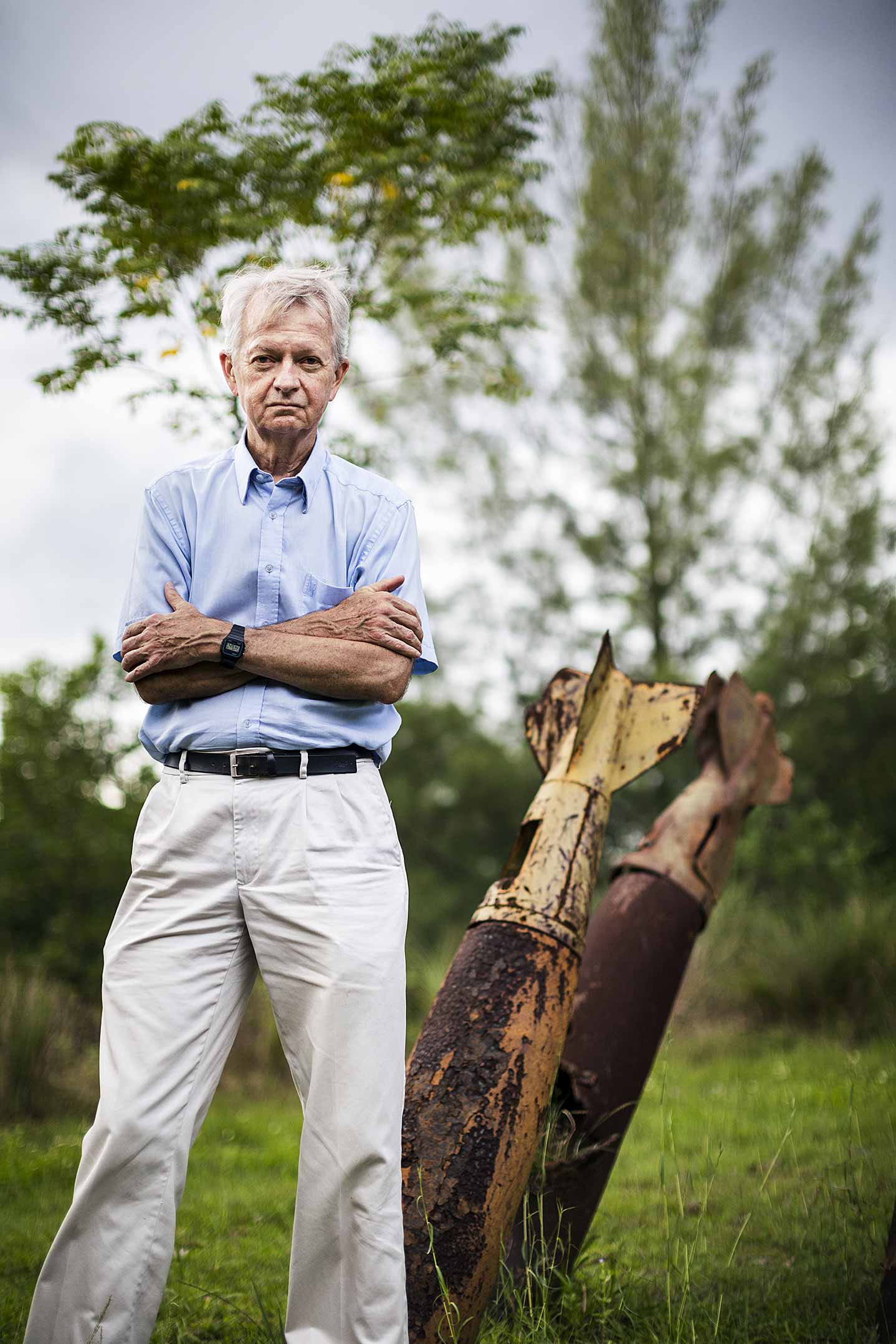
Nearly 40 years on, Chuck Searcy is still fighting the Vietnam War—but now for the other side. It’s a September morning and Searcy, a 69-year-old veteran, is overseeing a team of Vietnamese about to blow up a bomb discovered in a village in the central coastal province of Quang Tri. Because of its proximity to the old DMZ between what was once North and South Vietnam, Quang Tri was subject to relentless bombing by U.S. warships and planes. As a result, the area is infested with unexploded ordnance (UXOs).
Now, after a torrential downpour, a UXO—in this case a baseball-size cluster bomblet—has surfaced in a villager’s garden. Team members use sirens and megaphones to evacuate residents. Sandbags are placed around the explosive. Moments later a concussive detonation rumbles through the hamlet as the deadly weapon is destroyed. “It’s safe now,” Searcy, a co-founder of the ordnance-removal organization Project Renew, says in Vietnamese.
Long after the Vietnam War ended in 1975, Washington and Hanoi remained foes. Besides being ideological opponents, the U.S. imposed an embargo that hindered large investments in Vietnam. But their relationship improved rapidly after they normalized diplomatic ties in 1995. Today the U.S. is Vietnam’s third biggest trading partner and its biggest export market. The two have also been brought closer by their mutual concern over China’s rise. Hanoi is now a frequent stop for top American officials visiting Southeast Asia, and Washington is even thinking of easing an arms embargo on Vietnam.
Searcy underwent a similar journey of alienation and re-engagement. He wasn’t in Vietnam long—just about a year in the late 1960s, working as an intelligence analyst in Saigon (now called Ho Chi Minh City). That’s all it took to disillusion him. The North Vietnamese engaged in propaganda, but so did the Americans. Searcy says he massaged information to fit U.S. policy: “We were lying.” After the war was over, Searcy felt a sense of relief—and release. “I sort of put Vietnam behind me,” he says in his Southern drawl.
In the next 25 years, Searcy had successful careers in media, politics and public service. He started a weekly paper in Athens, Georgia (his home state), and helped run political campaigns. He also served six years as director of the Georgia Trial Lawyers Association. Yet, try as he did, he could not forget Vietnam. “For me and most American veterans, [it] was the most profound experience of our lives.” Searcy went back for the first time in 1992 with an army buddy. Over a month, the two traveled the length of the now unified communist country. Searcy says the trip was life-changing: “I was astonished at the complete lack of anger or bitterness or hostility from the Vietnamese toward us returning GIs. It was amazing.”
Searcy was struck, too, by the determination of the Vietnamese to rebuild their battle-scarred nation. “I began to think that I’d like to contribute because I felt some responsibility as an American for what happened there.” A few years after his visit to Vietnam, Searcy turned down a good job with the U.S. Department of Veterans Affairs in Washington. His new mission: help make Vietnam a safer place for its people.
During the Vietnam War, U.S. forces dropped anywhere between 8 million and 15 million tons of ordnance across Indochina—several times that used by Allied forces on the Axis powers in World War II. The U.S. Department of Defense estimates that at least 10% of the munitions failed to detonate on impact. Since the war’s end, some 100,000 people have been killed or maimed by the residual explosives. Vietnamese officials say 83% of Quang Tri province is contaminated by UXOs.
Searcy decided that they needed to be tackled in a systematic way. In 2001 he founded Project Renew with support from the Vietnam Veterans Memorial Fund and the Quang Tri People’s Committee. Key to the operations has been the use of Vietnamese teams and resources. The 100-strong outfit is staffed primarily by locals. The province’s Youth Union teaches adults and children to identify ordnance and then call a hotline run by Project Renew when bombs are discovered. Through Vietnam’s Department of Health and local hospitals, amputees are fitted with prosthetics, while the Women’s Union helps manage microcredit loans for victims. “I’m very grateful to international organizations and friends who come back and help clean up the deadly remnants of war,” says retired Vietnamese colonel Bui Trong Hong, Project Renew’s national technical officer. “People like them understand how badly our country was devastated.”
Just in the past 24 months, Project Renew has eliminated about 27,000 pieces of ordnance, with only one accident reported in the past year in the districts where the teams operate. “[The system] results in a lot more ordnance destroyed on a daily basis,” says Searcy. Project Renew wants to scale up the Quang Tri model nationwide with the help of additional funding from the U.S. government. “It could happen in the next five to 10 years, at which point we Americans step back and can say we finally did what we should have done 40 years ago,” says Searcy. Perhaps then, for him, the war will be truly over.
More Must-Reads from TIME
- Cybersecurity Experts Are Sounding the Alarm on DOGE
- Meet the 2025 Women of the Year
- The Harsh Truth About Disability Inclusion
- Why Do More Young Adults Have Cancer?
- Colman Domingo Leads With Radical Love
- How to Get Better at Doing Things Alone
- Michelle Zauner Stares Down the Darkness
Contact us at letters@time.com